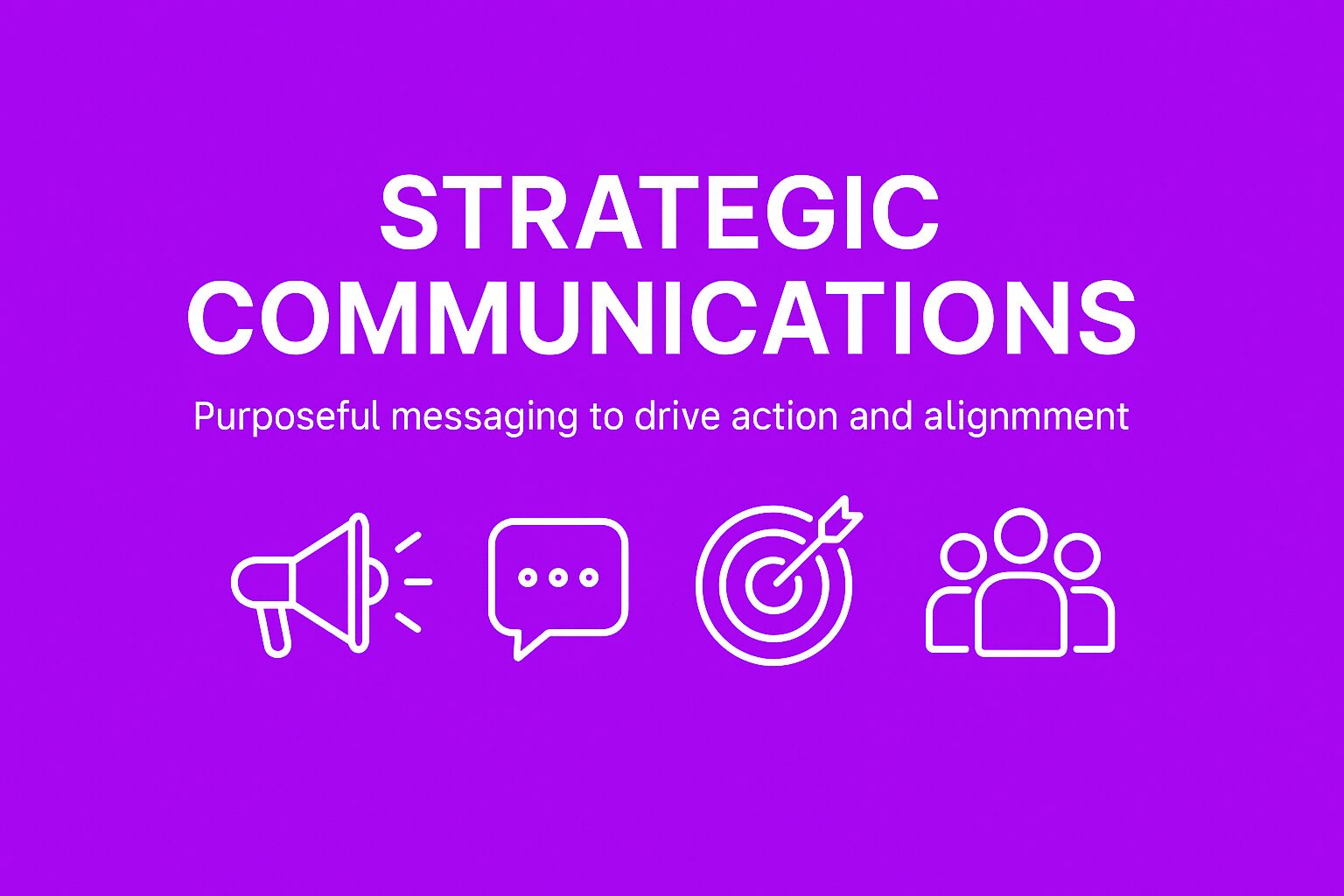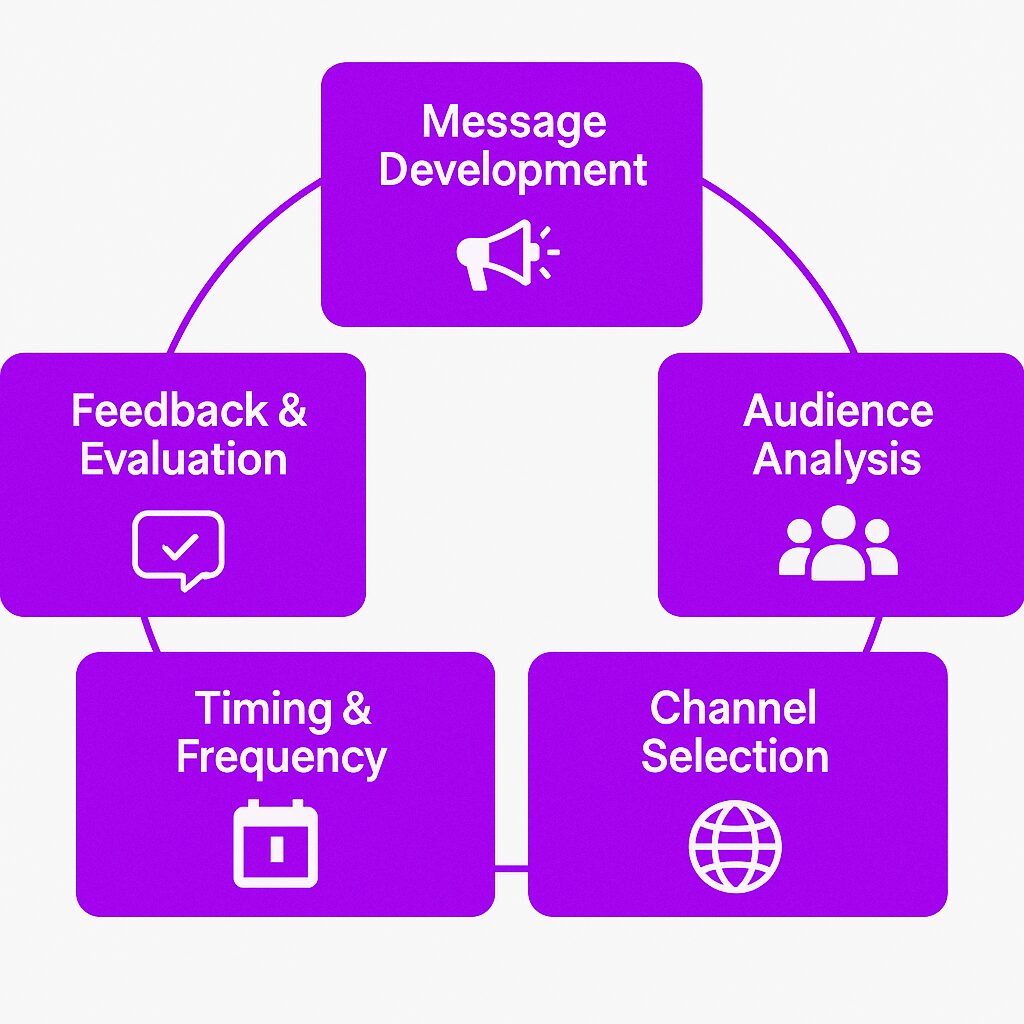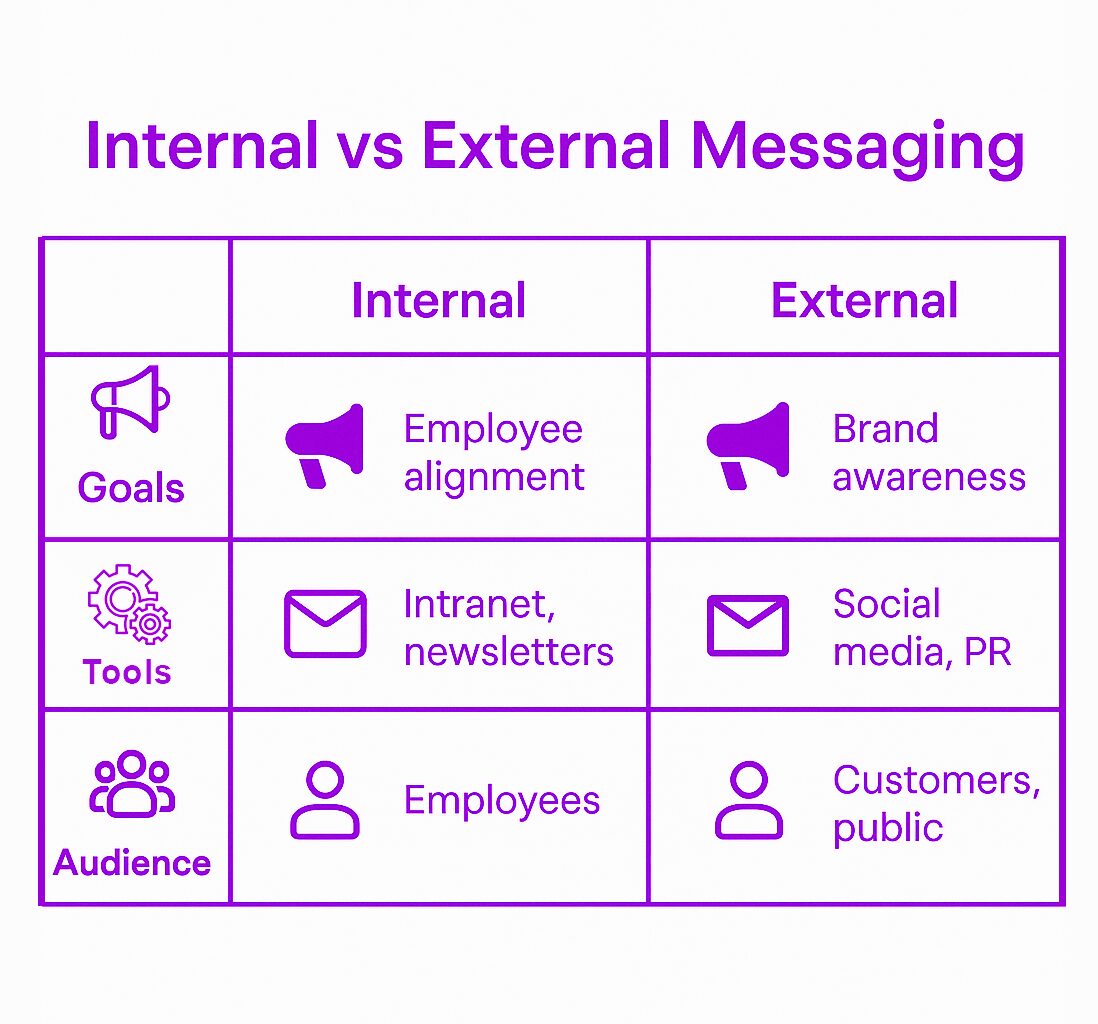What is a Communication Strategy?
Strategic communications is the intentional process of delivering messages designed to influence, inform, and engage specific audiences in alignment with an organization’s overall goals. It is not just about transmitting information; it’s about ensuring that the message serves a purpose and helps drive desired actions through coordinated communication activities. Engaging key audiences is crucial for achieving organizational objectives, fostering relationships, and maintaining trust.
Effective strategic communications involve identifying key messages, choosing the right channels for communication, and executing the message in a way that supports long-term objectives, whether internal (like engaging employees) or external (like building customer loyalty). It is an essential component for achieving an organization’s strategic goals and should be thoughtfully aligned with the organization’s mission, business priorities, values, and culture.
Comprehensive Explanation
Strategic communications cover a wide range of practices and tactics across different channels, both traditional and digital. It includes corporate messaging, public relations, internal communications, marketing, crisis management, media relations, and stakeholder engagement. Planning and evaluating communication tactics is crucial for enhancing an organization’s competitive positioning.
The key aspect of strategic communications is that each message is crafted and delivered with a clear purpose, targeted to the right audience, and aligned with the organization’s larger strategy. It’s not just about talking, it’s about ensuring the right conversation occurs at the right time and that the message ultimately drives the desired outcome. Evaluating the effectiveness of communication strategies across various media platforms is essential to measure true success, which lies in enhancing brand awareness and driving sales.
Strategic communications involve the thoughtful selection of various communication methods, tools, and mediums to ensure that your audience receives and understands the message. Whether you are working on communicating internally with employees or externally with the public or customers, strategic communication ensures that all messages are aligned with the broader organizational objectives.
Key Elements of Strategic Communications: Communication Channels
-
Message DevelopmentCrafting the right message is the foundation of strategic communications. Messages should be clear, concise, and consistent, and they must resonate with the target audience. A well-developed message effectively conveys the organization’s values, vision, and purpose while also motivating the audience to take action. Effective messaging can provide a competitive advantage by enhancing both internal and external communications.
-
Audience AnalysisTo craft effective messages, you first need to understand the audience. Audience analysis involves segmenting your stakeholders—whether they are employees, customers, investors, or the general public—based on their needs, interests, concerns, and preferred communication methods. By understanding who you’re communicating with, you can tailor your message to fit their context, increasing its impact.
-
Channel SelectionThe medium through which a message is communicated plays a significant role in its effectiveness. Whether using email, social media, websites, press releases, or face-to-face meetings, selecting the appropriate communication channel for your audience and message ensures that the message is not only heard but also acted upon.
-
Timing and FrequencyTiming is critical in any communication strategy. Delivering a message at the wrong time can have adverse effects, such as missing an opportunity or losing relevance. Strategic communication involves careful planning to ensure that messages are delivered at optimal times, whether that’s during a product launch, a crisis situation, or a time when employees need to receive critical updates.
-
Feedback and EvaluationContinuous improvement is central to strategic communications. It’s important to track and evaluate how well communications are received by the audience. Feedback mechanisms—such as surveys, audience response, engagement metrics, and internal reviews—help you assess the success of your strategies and adjust them as needed.
Purpose and Importance of Strategic Communications
The importance of strategic communications cannot be overstated. At its core, it helps organizations stay aligned, relevant, and effective in their messaging to both internal and external audiences. Coordinated communication activities play a crucial role in achieving organizational goals by ensuring that all efforts are aligned with strategic objectives. By having a clear and actionable communication strategy in place, organizations can manage perceptions, improve employee engagement, enhance customer loyalty, and drive growth.
Aligning communication efforts with the organization’s mission and goals is essential for enhancing organizational success and competitive positioning. Effective strategic communication should resonate with the organization’s values and be integrated into the planning stages to achieve a cohesive messaging strategy that supports overall objectives.
Purpose of Strategic Communications
-
Fostering RelationshipsStrategic communications build and maintain strong relationships with stakeholders, both inside and outside of the organization. Clear communication helps increase trust, engagement, and collaboration, leading to stronger, long-lasting relationships. Effectively engaging key audiences is essential for building and maintaining these relationships, as it ensures that the needs and expectations of specific groups are understood and addressed.
-
Supporting Organizational GoalsEvery communication should align with the organization’s strategic objectives. Whether the goal is to improve brand awareness, drive sales, or improve employee retention, communication plays a critical role in reinforcing these objectives and ensuring they are understood by the relevant parties.
-
Crisis ManagementOne of the most important applications of strategic communications is in times of crisis. Whether dealing with public relations issues, internal conflicts, or unexpected events, a well-crafted communication strategy can mitigate the damage, keep stakeholders informed, and restore trust.
-
Promoting TransparencyTransparency is critical in today’s world, especially as companies face heightened scrutiny. Strategic communications help organizations maintain transparency, providing clear and honest communication to stakeholders about the company’s activities, performance, and challenges.
-
Influencing Stakeholder BehaviorStrategic communications are designed to influence the behavior of key stakeholders. Whether it’s customers making purchasing decisions, investors deciding where to allocate resources, or employees aligning with company goals, effective communication can lead to the desired action.
Importance in the Modern Business World
In an era where information is abundant and the attention span is limited, strategic communications help an organization stand out. Digital media, social networks, and a globalized workforce have made it more difficult to communicate effectively, making a strong strategic communication plan even more critical. Organizations can’t afford to simply hope their messages will be heard—they need to ensure that every communication effort is purposeful, focused, and targeted to the right people at the right time. Evaluating and measuring the effectiveness of these efforts across various media platforms is essential to enhance brand awareness and drive sales.
Benefits and Challenges of Strategic Communications
Benefits
-
Improved EngagementWhen messages are well-crafted and appropriately targeted, they foster greater engagement from both employees and customers. For internal communications, engaged employees are more productive, committed, and aligned with organizational goals. For external communications, a well-engaged customer base is more likely to convert and remain loyal.
-
Increased Organizational EfficiencyA well-structured communication strategy can streamline the flow of information across the organization. By ensuring everyone is on the same page, strategic communications help eliminate confusion, reduce miscommunication, and promote efficiency in decision-making and action.
-
Enhanced Brand and Reputation ManagementEffective communications help organizations build and maintain a positive public image. With strategic messaging, businesses can highlight their strengths, address weaknesses, and foster goodwill with the public, ensuring their reputation remains strong even in challenging situations. Additionally, strategic communications can provide a competitive advantage by fostering goodwill and maintaining a positive public image.
-
Stronger Employee Morale and ProductivityEmployees are more likely to feel valued and motivated when they understand the direction of the company, the goals they are working toward, and the role they play in achieving those goals. Internal strategic communications help foster a sense of belonging and purpose within the organization, leading to higher morale and productivity.
-
Effective Crisis ManagementStrategic communications play a critical role in managing crises. A well-planned crisis communication strategy helps organizations respond quickly, provide timely updates, and maintain trust and credibility even in the face of adversity.
Challenges: Crisis Management
-
Complex CoordinationIn large organizations, coordinating communication efforts across departments, teams, and geographic locations can be challenging. Ensuring that all messages are aligned with the organization’s objectives and values requires careful planning and constant communication across different parts of the business.
-
Adapting to Rapid ChangeThe speed at which the media landscape changes—especially with the rise of social media and digital platforms—requires organizations to constantly adapt their communication strategies. What worked yesterday may not be effective today, and organizations need to be flexible enough to pivot when necessary. Continuously evaluating and adapting communication tactics is crucial to stay effective in this dynamic environment.
-
Overcoming Internal ResistanceIntroducing or refining a strategic communication strategy often meets resistance, particularly if it involves changes to the way things have been done. Whether it’s skepticism from senior leadership, reluctance from employees, or a lack of resources, overcoming internal resistance can be one of the biggest challenges to implementing effective communications.
-
Measuring EffectivenessUnlike sales or marketing campaigns, where the results are often quantifiable, measuring the success of strategic communications is more nuanced. While engagement and feedback can provide insight into the impact of a message, it can be difficult to directly correlate communications with business outcomes like revenue or employee retention.
Creating a Communication Strategy
Creating a communication strategy is a crucial step in achieving an organization’s goals and objectives. A well-planned communication strategy ensures that messages are conveyed effectively to the target audience, whether internal or external. This process begins with identifying the organization’s mission, vision, and values, which serve as the foundation for all communication efforts. Understanding the needs and preferences of the target audience is equally important, as it allows for the tailoring of messages that resonate and drive engagement.
A comprehensive communication strategy should be tailored to the organization’s specific goals and objectives. It involves a combination of internal and external messaging, ensuring that all communication efforts are aligned and integrated. This is where a strategic communication plan comes into play. The plan should outline a clear course of action, including a budget and timeline, to guide the implementation of the strategy. Regular monitoring and evaluation are essential to ensure that the strategy is achieving its intended goals and objectives, allowing for adjustments as needed.
Communication Channels and Messaging
Communication channels and messaging are critical components of a successful communication strategy. The choice of communication channels depends on the target audience and the organization’s goals and objectives. Common channels include social media, email, press releases, and internal communications. Each channel has its strengths and should be selected based on where the target audience is most active and receptive.
Messaging should be clear, concise, and compelling, tailored to the target audience to ensure it resonates and drives the desired action. Integrated marketing communication (IMC) is a key concept in this context. IMC involves coordinating all aspects of marketing and communication to create a unified message. This approach ensures that all communication efforts are working together harmoniously to achieve the organization’s goals and objectives. Effective messaging requires a deep understanding of the target audience’s needs and preferences, allowing for the creation of messages that are both relevant and impactful.
Strategic Communication Plan Development
Developing a strategic communication plan is a critical step in achieving an organization’s goals and objectives. This plan should be tailored to the organization’s specific needs and goals, providing a clear roadmap for implementation and evaluation. A well-crafted strategic communication plan includes a detailed budget and timeline, ensuring that resources are allocated efficiently and that progress can be tracked over time.
The development of a strategic communication plan begins with a situation analysis, which involves assessing the organization’s internal and external environment. This includes conducting a SWOT analysis to identify the organization’s strengths, weaknesses, opportunities, and threats. The plan should also include a clear statement of the organization’s mission, vision, and values, which serve as the guiding principles for all communication efforts. By outlining a detailed plan for implementing and evaluating the communication strategy, organizations can ensure that their communication efforts are aligned with their overall goals and objectives, leading to more effective and impactful outcomes.
Practical Tips and Best Practices
-
Define Clear Communication ObjectivesBefore developing a communication strategy, ensure the goals are clearly defined. Whether the goal is to increase brand awareness, improve employee morale, or respond to a crisis, clear objectives help to guide the message and evaluate its effectiveness.
-
Segment Your AudienceUnderstanding your audience is critical. Different stakeholders have different needs, expectations, and preferred communication channels. Segment your audience to ensure messages are personalized and relevant to each group.
-
Use Multiple ChannelsDepending on your audience, you may need to communicate via several channels. This could include social media, email newsletters, press releases, company meetings, or intranet systems. The key is to ensure that your message is accessible to the target audience, wherever they are.
-
Monitor and AdaptCommunication is not static, and neither is your audience’s behavior. Regularly assess the effectiveness of your communications and make adjustments as necessary. Pay attention to feedback, engagement metrics, and shifts in the public mood to refine your strategy. It is also important to regularly assess and refine communication tactics to ensure they remain effective and aligned with your organization’s core messaging and objectives.
-
Be Transparent and HonestOne of the cornerstones of strategic communications is trust. Being transparent about the challenges your organization faces and honest about its progress or shortcomings helps build credibility and strengthens relationships with stakeholders.
-
Foster Collaboration Across DepartmentsStrategic communications require input and coordination from different areas of the organization. Encourage collaboration between marketing, HR, legal, and other departments to ensure consistency across all messaging.
Related Sub-concepts: Internal and External Messaging
Internal Communication
Internal communication refers to the flow of information between individuals and teams within the organization. This could include communication about company policies, employee engagement, team-building activities, and more. Strategic internal communication helps to foster a positive work culture, keeping employees aligned with organizational goals and objectives.
External Communication
External communication targets those outside of the organization, including customers, investors, and the general public. Various media platforms play a crucial role in reaching and engaging these external audiences, enhancing brand awareness, and driving sales.







